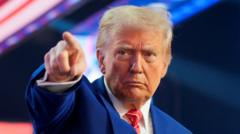President-elect Donald J. Trump’s announcement to impose significant tariffs on major trading partners raises concerns about economic destabilization and international cooperation, reflecting his strategy to leverage the U.S. market to address broader issues.
Trump’s Tariff Threats Reshape Global Trade Landscape

Trump’s Tariff Threats Reshape Global Trade Landscape
The newly elected president's preemptive tariff proposals target Canada, Mexico, and China, sparking fears of a trade war and impacting international relations before he takes office.
President-elect Donald J. Trump’s recent threats to implement tariffs on Canada, Mexico, and China have sparked significant discussions about the potential long-term effects on global trade. This move appears to be a calculated strategy to leverage the substantial U.S. market power to negotiate terms regarding drug and migrant flows, but it comes with immediate complications.
Even before Trump officially assumes office, his declaration of a 25 percent tariff on goods from Canada and Mexico, along with a 10 percent tariff on Chinese products, has sent shockwaves through international business communities. Leaders and officials from affected nations have quickly responded, emphasizing their continued efforts to control border issues while warning of possible retaliatory tariffs on U.S. exports.
The outcry from business sectors highlights the potential adverse impacts on economies, as many rely heavily on interlinked supply chains throughout North America and Asia. Trump’s rhetoric echoes earlier campaign promises of imposing a 60 percent tariff on Chinese goods and a minimum of 10 percent on imports from other countries, raising fears of igniting a global trade conflict.
While some analysts may interpret Trump's strong stance as a display of robust negotiation skills, others warn it could lead to economic chaos and strain the very alliances he built during his previous term. Observers are keenly watching to see how this approach affects the trade agreements Trump negotiated earlier, particularly with Mexico and Canada, and whether it genuinely serves U.S. interests or creates further divisions in international trade relations.


















